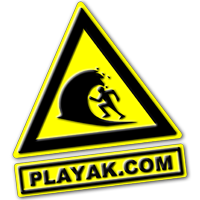[please login to make this ad block disappear]
Articles
The future of SUP
| The future of SUP |
 |
| Simon Westgarth Owner, Gene17 |
 |
Fringe Paddle Sports Discipline
I foresee SUP going the way of fringe paddle sports disciplines, like dragon boat racing, sea ski racing and waveski paddling. We're related in that we use a paddle, but that is where it all ends. SUP purists would more likely consider themselves surfers with paddles, and within the surf community SUP is a side attraction, yet an acceptable fitness option.
There is little crossover from those who have tried both, with the exception of a few high profiled kayakers come SUP paddlers, some through commercial ends. I have not read or met any normal paddlers that have taken up SUP after they tried it, nor SUP paddlers who have become kayakers.
I think it's not going to be a popular transition, and within 5 years, there will be little SUP within the paddlesport media.
| Corran Adisson Kayak & Board Shaper, Owner, Imagine Surf |
 |
More than a Trend
It's very difficult to predict something like where a sport will be in 10 years, particularly because it's so new. We're in the very beginnings of SUP and so long term vision is tough. This is not the Wright brothers' first flight, but it is the Sopwith Camel of WW1. They could never have predicted jumbo jets and global travel.
There are a few knowns. SUP is by all accounts the fastest growing water sport in the world, and possibly the fastest growing sport period. SUP has evolved from being almost entirely a surfing based activity 2 years ago, to that part of SUP being the smaller part of the sport today. We can expect this trend to mirror whitewater kayaking, which was the largest part of paddlesports in the early 1980's and 20 years later by 2000 was a microscopic part of paddlesports.
SUP is attractive to people because it has the combination of the ease and accessibility of flat water kayaking, with the sexiness and imagery of surfing combined. It takes 5 minutes to be an expert and believe you're in Blue Crush. In 2009 over 50 million Americans were involved in outdoor activities, 18 million of them in paddleports. I believe that SUP will have a greater appeal than the other paddlesports divisions to the mass outdoor market, but this remains to be seen.
We are seeing a definite trend of kayakers and canoeists in both the flat water and whitewater realms trying SUP. In whitewater circles SUP offers a fun challenge and diversification from the hum drum of paddling the same river over and over again, and particularly for the older paddlers in their 40's who now have family commitments, are less prone to want to challenge themselves in risky whitewater, and SUP offers a "safer" alternative with the same technical challenge. SUPs are also less expensive than kayaks so it's an inexpensive way to feed that desire to get a new toy, at half the cost. In the flat water and touring circles, SUP offers a greater global vision of your environment, a better all body work out, a less stressful body position, and with the new SUPs allowing you to sit when tired, greater diversification.
Is SUP just a trend? Unlikely. It's too enjoyable, and accessible to the masses to simply come and go. It's here to stay - the question is what form will it take.
| Graham Mackereth President, Pyranha |
 |
Another way of having fun afloat
As Kenneth Graham said: "Believe me, my young friend, there is nothing - absolute nothing - half so much worth doing as simply messing about in boats."
SUP will be another way of having fun afloat, and before too long the manufacturers' hype will disappear, and it will settle in to what it will become - another way to have fun and exercise afloat.
I believe it will be more of an alternative to sit-on-tops than for many other of kayaking's elements.
I think for the UK, the main market could be in outdoor centers: it is easy to teach and easy to have fun with. I don't see people progressing in it though, rather just doing it as a one off summer thing, maybe a progression from the sit-on-top, maybe a fitness thing.
| John Hoge Vice President, Sea Eagle |
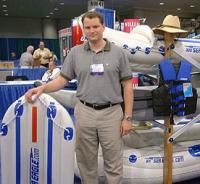 |
Global Growth
Demographers tell us that 4 billion people will be moving into the global middle class by 2050. This unparelleled change in global wealth is going to produce booming demand for products the new middle class will want. People who were never in the market for middle class products will suddenly be demanding cars, improved housing, travel, higher education and recreation.
All that demand for cars and air conditioned housing is going to shoot the price of energy beyond levels anyone has seen in their lifetime. For the emerging middle class, burning 50 gallons of gas to enjoy a day on the water just won't be an option.
People will want to enjoy the outdoors more than ever, and gas will be prohibitively expensive, so paddlesports is the industry logically set up to benefit from this trend. I would think that the center of gravity of the paddlesports industry will move east to follow this new customer base.
SUPs will play a big roll in this due to portability and relative low cost. Inflatable boards, being much more portable, will gain wider acceptance even at a price premium because of their ability to easily fit tiny Asian apartments.
| Paul Robertson Palm Equipment |
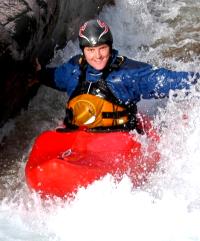 |
Into the Mainstream, out of Paddle Sports?
Not so long back SOT appeared recreationally and became arguably the most successful propulsion of paddlesports into the mainstream as a participant activity. As the category established itself diversification took place to cross boundries, kayak fishing probably being the most notable.
I imagine that SUP will follow a similar pattern. The diversification is already happening opening up a wider audience, plus the majority of the design and engineering know how has already been developed by manufacturers of other water craft - so an easy translation.
As an industry SUP's issue is where it fits. Is it part of the surf industry, part of paddlesport, strong enough to stand alone, or does it not matter? Sea, surf and sex sell, so the surf association undoubtedly has helped create a springboard. But the development of the recreational end associated with paddlesport may stand a better chance of longevity.
In today's outdoor market versatility is key. With SUP some will tire, or find standing and balancing difficult, so its possible the future is both standing up... and sitting down.
| Peter Sturges Owner, Otter Bar Lodge, California |
 |
Good full body work out
Otter Bar Kayak school will be offering SUP/River classes in August 2011. At first glance SUP would seem a total fad (and very silly looking) unlikely to last. My son Rush had to repeatedly insist that I include it in our offerings. The revelation comes as soon as you get on one and start paddling around.
As a paddler already and with a well honed understanding of river hydraulics, the sensation, increased vision and challenge is alluring. The aerobic hit is huge and while you spend a lot of time falling in and getting back on, the challenge is worth it. Very easy to get a full body work out in a short time on easy water.
Will it last? It is so simple, non threatening and easy (at least on flatwater) that I suspect it will have a permanent place in many people's exercise regimen - myself included.
| Philip Curry CEO, Astral Buoyancy Company |
 |
Strong and Steady
I think SUP as a trend in paddlesports will continue to grow for a couple more years then level off and maintain a user level similar to whitewater now. From a marketing level- it's way over-hyped right now, but I expect that will end soon. A few good board companies will be defined as the market essentials.
Because SUP is considered clumsy and oversized when compared to the pure sport of surfing it has not gained much traction in the surf world. So, the SUP industry has found paddlers to be their next target market. In response, and to protect their turf, we now have every kayak company claiming expertise in SUP and selling boards beside their fishing kayaks.... its gotten to be a bit too much.
However, I think that the fact that kayaking icons / pioneers like Dan Gavere and Corran Addison along with star surfers like Laird have found so much fulfillment in the sport indicates it is an activity that is built to last.
| Earl Richmond Owner, CKS |
 |
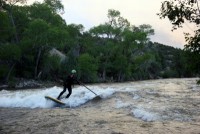 |
SUP has a bright future
SUP will be a long lasting form of paddling for people of all ages and abilities over the world. The sport has received a lot of press in the past 2 years, but really, it is just getting started and will grow exponentially in years to come.
SUP is available to anyone almost anywhere there is water. You can paddle ponds, lakes, bays, ocean surf, flat rivers, moving rivers, whitewater rivers and much more. The opportunities are endless and are also super accessible.
My view on SUP is that it is a positive outlet to keep people paddling. We loose customers to other activities like biking, hiking, climbing and many other sports that compete for people's limited free time. SUP is a relatively easy form of paddling and is safe and will get you into great shape. This is why so many people are seeking SUP out. Many of our customers who have been bored with kayaking, scared of kayaking, or struggling with kayaking, are trying SUP and telling us that SUP is now what is keeping them on the water. SUP is a great option for people when they are asked what kind of paddling they would like to do this year. SUP is keeping the excitement of paddling alive for so many people out there.
Like with any new sport the designs will change dramatically, not only every year, but every season. We will see changes in boards, paddles and gear that are chasing the progression of SUP. Having so many options will allow even more people to participate in SUP. But it will also create some issues down the line. We are seeing almost every company jump into SUP design and distribution, which does not always work out well in the long haul. A flood of retail options and the potential of confused customers.
Give SUP a try, you may be amazed at what you have been missing. If you do not like it, at least you can say you tried it and you will have real life feedback for those that ask about it.
| Antoine Elie Owner, Pelican Sports |
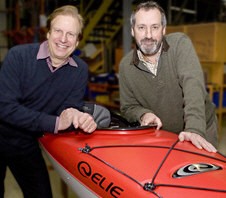 |
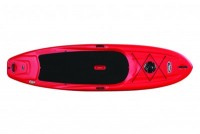 |
| Pelican's Flow 106 SUP |
Growth in Touring SUPs
Today, the surf and racing categories of SUP are well established. There are numerous models and many well organized competitions throughout the world.
We are beginning to see new categories such as touring, flat water, white water and angler, but there are very few models developed specifically for these categories. People tend to use their all-around board and outfit it the best they can.
I believe that we will see growth in touring SUPs, specifically those that are adaptable. Plastic SUPs are an interesting option since their construction allows for interior compartments where baggage and gear can be stored. Optional gear can be solidly screwed into the plastic as well.
We will also see growth in SUPs adapted to river running (the equivalent to white water kayaks). This discipline will attract white water kayakers who will find a new thrill navigating rapids that had become too easy in their kayaks.
More and more SUPs will be equipped specifically for fishing as well.
This sport is in its infancy, so I believe that there are many years of growth ahead as SUPs become more mainstream and accessible.
In 2020 SUP use will not be confined to a small group of early adopters, but to a wide variety of users from casual paddlers at the cottage lake to Olympic athletes. The sport will most likely be chosen as a demo sport in the Olympics in the next little while. Following the C1, C2, K1, K2 will be the S1!
| John Weld Owner, Immersion Research |
 |
Intersection between SUP and Paddlesports Only Really Occurs at the Paddle...
As a paddle sports gear manufacturer, we obviously are interested in any potential new markets and as a result we have been watching SUP closely and have spent a lot of time internally talking about it, as well as discussing it with our retailers. We have also acquired a few SUP boards here at IR, and we have tried them in a variety of conditions including the lake with our families, a class III river nearby, as well as in the surf. Here is what we have come up with so far:
The boards were a great deal of fun with the kids at the lake. But I would put the price tag on that kind of fun at around $200 max. The idea of spending $800 or more dollars on that kind of activity is really unreasonable. On the river the boards were a lot of fun for those of us who had paddled that river 1000's of times, but the fun was found in how difficult it was, and how we found ourselves falling into rocky class III rapids continuously. This will have very, very limited appeal. In the surf, the boards were a tremendous amount of fun. Both experienced surfers and and novices alike were able to enjoy the boards almost immediately.
I have also heard many people discuss that the boards are "a great workout" - and it is - but this is a thin argument for me. In regards to a good outdoorsy workout, SUP will have to compete with dozens of other sports that are either a lot cheaper, a lot more conventional, more dynamic, or all of the above. This would include trail running, biking, hiking, etc, etc. Other than that, most Americans looking to spend money on a piece of exercise equipment want something they can drop in front of the TV.
Our conclusions, at least thus far, are that we think that SUP will see a great deal of success in coastal areas in both rental programs and for consumers, and you will see a wide variety of boards being sold to these locations- from very cheap rotomolded boards to very expensive composite boards. Most of these sales will occur in resorts/ beach rental outfits and surf shops.
Inland, we think that SUP will have a more limited appeal, and the sales that occur there will tend to be price point boards. Families, fishermen, inland rental fleets and casual recreationalists do not need and will not buy an expensive SUP. People under, say, 25, are not going to buy an SUP for a lake- it's too boring. River running SUP will be very small and limited to handful of expert kayakers who can get boards at a discount/proform. As a result the biggest beneficiary of this kind of market will be manufacturers who can make cheap boards and retailers like Dicks that can sell sub $200 boards at cut-throat margins. This is not a marketplace that is friendly to specialty retailers, or us.
In the end, we see very limited potential for IR. High end users who actually need extra gear will almost certainly buy it from surf shops and buy surf brands (Quicksilver, etc), and everyone else won't need gear beyond a paddle and sunblock.
This is not to say that we don't like SUP, or don't think it will grow into a very large marketplace. Paddle makers and rotomolders in our sport should be able to do quite well here. I think high-end composite boards will be sold successfully by companies with real street-cred in surfing (like Laird), but will be a very tough sell for kayak brands. But there seems to be this industry-wide sentiment that because SUPers use a paddle, there is some mandate that they are "paddlesports" and that if we don't get in, we are missing a huge opportunity. We really see the intersection between SUP and paddlesports only really occurring at the paddle. That's about it.
Conclusion
There seems to be a general consensus that SUP will continue to grow into the mainstream, but because of that, it's very questionable if it will have much to do with paddling in the end. Sure, SUPers use a paddle, and it's likely that companies that already make kayaks and boards will also be good at making SUPs, but that may be where the ovelap ends. Kayakers form a small niche community, so it's hard to imagine that SUP as a mainstream activity will identify with it, even though the kayakers themselves may consider SUP a nice and sexy form of paddling.
And from the surfers' point of view? Surfers are not exactly open to sharing their waves with other craft, especially if those craft can catch the waves easier because they use paddles, so even though some top-profile personalities out there are pushing SUP right now, it's likely that hardcore surfers will continue to regard SUP as a freak show.
And so if SUP will indeed grow into the mainstream, it will probably also be integrated more into the mainstream sales channels, fitness and outdoors schools, etc.
I know for sure that I like doing SUP for fitness and diversion, but then again, it may be just because I'm getting old, and I may get fed up with it soon and return to kayaking only. Time will tell... Let's do a retrospective article here on Playak in 2020 - I'll mark my calendar :)
For Playak,
Jeroen
